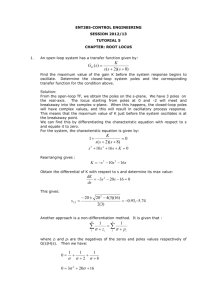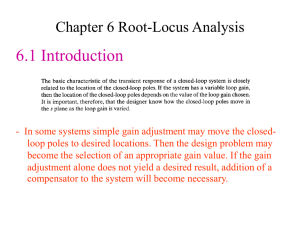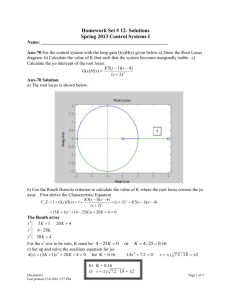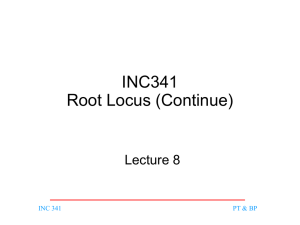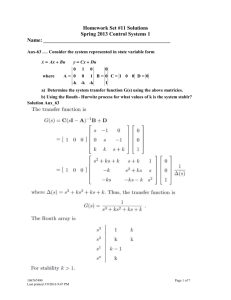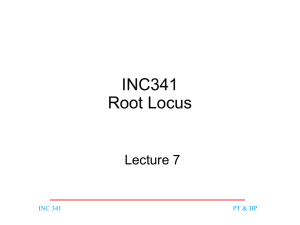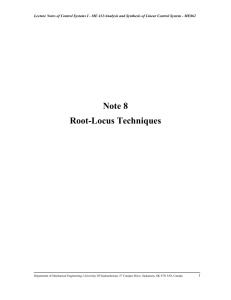Document
advertisement
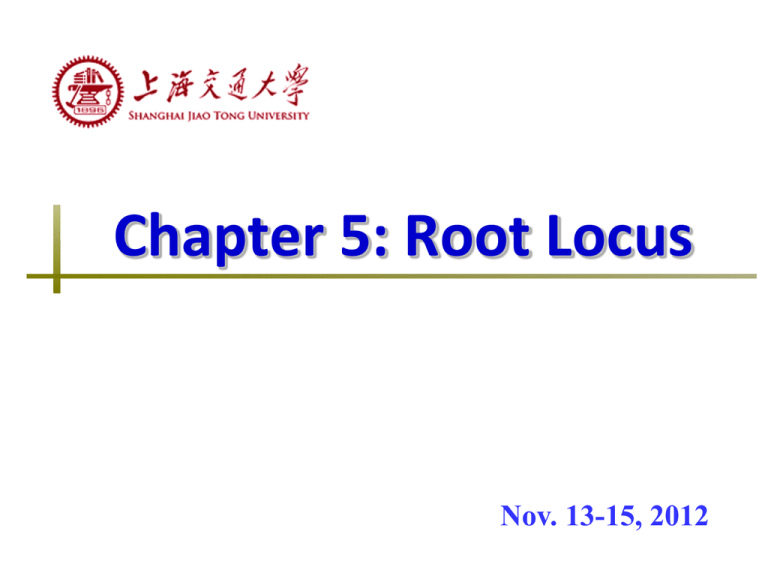
Chapter 5: Root Locus Nov. 13-15, 2012 Two Conditions for Plotting Root Locus Given open-loop transfer function Gk(s) m Characteristic equation Gk s K g ( s zi ) i 1 n (s p ) j 1 1 j Magnitude Condition and Argument Condition n | (s p ) | j Kg j 1 m | ( s zi ) | i 1 m n i 1 j 1 (s zi ) (s p j ) (2k 1) , k 0,1,2.. Rules for Plotting Root Locus Content Rules 1 Continuity and Symmetry Symmetry Rule 2 Starting and end points Number of segments 3 Segments on real axis 4 Asymptote n segments start from n open-loop poles, and end at m open-loop zeros and (n-m) zeros at infinity. On the left of an odd number of poles or zeros n-m segments: = 5 (2k 1) , k 0,1,2, nm n Asymptote m ( p ) ( z ) j 1 j i 1 i nm 3 6 Breakaway and break-in points d [ F s ] 0 ds F s Ps K g Z s 0 Ps Z s P s Z s 0 m n 1 1 i 1 zi j 1 pi Angle of emergence 7 Angle of emergence and entry m n i 1 j 1 j p m p (2k 1) i j Angle of entry n z (2k 1) j i j 1 8 Cross on the imaginary axis i 1 i z Substitute s = j to characteristic equation and solve Routh’s formula 4 Rule 6: Breakaway and Break-in Points on the Real Axis Breakaway point j Break-in point j Use the following necessary condition dK g dGs H s d 1 0 or 0 or 0 ds ds Gs H s ds 1 1 Ps Z s P s Z s 0 s zi s pj 2015/4/13 5 Example 5.3.1: Given the open-loop transfer function, please draw the root locus. k ( s 3) G( s) H ( s) zero pole k =5.818 pole k =0.172 ( s 1)(s 2) 6.Breakaway and break-in points 1.Draw 2. Two the segments open-loop poles and 4. Segments on real axis 3.Symmetry 5.Asymptote zeros 180 (2k 11) 1 1801 2 1 3 a Break--3 in -2 breaka -1 way 1 a n m p a 3zi j j 1 i 1 n s pn m a 1 a 2 j k j 1 m s zi 2a 2 (1 2) 3 0 2 1 a3 i 1 2015/4/13 6 Example 5.3.2: Given the open-loop transfer function K * ( s 1) Gk ( s ) s2 j s1 please prove that the root locus in the complex plane is a circle. 0 s2 Conclusion: For the open-loop transfer function with one zero and two poles, the root locus of characteristic equation is probably a circle in the complex plane. Example 5.3.3: G(s) H (s) K s ( s 1)( s 2) 5. Points across thebreak-in imaginary axis 4. Breakaway points 3. 2. 1.Asymptotes Segments Open-loop onand poles real axis and zeros j1.414 K=6 -2 -1 -0.42 K=6 -j1.414 2015/4/13 s Z s 0 Pss3Z s180 (22 k s1)K 0 3s22P [3s 6s 2] 60 ,180 yields 0 3 31 0 2 s solution s1 0.42 s2 1.58 0 1 2 2 s 3 K1 0 63K 1 s 3s 2 6 0 3 s0 K K=6 8 Example 5.3.4: G( s) H ( s) k ( s 1) 2 ( s 1 j18)(s 1 j18) 1.7.The Find point poleswhere and zeros the locus points 3. Symmetry 6. 5. Breakaway Asymptote and break-in 2.No 4 segments 4. segments on realaxis axis across the imaginary j3.16 k =121 Breakaway -1 k =121 -j3.16 2015/4/13 4 2 23180 sd [( 4 s 24 s k 0 ( 2 k ) 1sj19 )] s 1) (s 1 j18)(1s40 18 45 或0135 4 dsm2 24 19 k s4 1 n 3 yields sp j3 s z i12s 10 0 3 s 1 101 1 j3 j 4 1 i 11 40 1 Solutions s s 2,3 1 1 s2 14n m 19 k 4 484 4k 1 s 02 140 0 14 s 14 s0 19 k s j3.16 484-4k=0 getk =121 9 Example 5.3.5 Rs K s 0 .5 s 0.5s 1 C s 2 Please sketch the root locus with respect to K=[0,+∞). Extension of Root Locus Canonical form Gk ( s) K g m (s z ) i i 1 n (s p ) 1 Conventional Root Locus j Root locus gain j 1 1. How to sketch the root locus for other parameters? 2. How to sketch if Gk(s)=1 2015/4/13 Parameter Root Locus Zero-degree Root Locus 11 5.3.2 Parameter Root Locus Example 5.3.6: Ks is a ramp feedback gain, please sketch the root locus with respect to Ks=[0,+∞). s 2 (2 10K s )s 10 0 dFs2s 02s 10 10K s s 0 ds 10K s s s 2 10 3.12 1 0 198o s n2 s 10 1 G ' ( s)sH 'p( sj ) 0 108o 10K s j 1 m 10 K s s G ' ( s ) H 's(s )z 2 s z i i 1 90o 2015/4/13 s p1 s p2 s 2 s 10 1.2.Break-in and breakaway point 3.65of 3.65 Angle emergence 4.3 3.12 180 (90 108 ) 198 12 5.3.2 Zero-degree Root Locus Example: Sketch the root loci of the system with the open loop transfer function: K1 (1 s) G( s) H ( s) s( s 1) Analysis: K1 : 0 K1 (1 s) K1 ( s 1) G(s) H (s) s( s 1) s( s 1) For this kind of systems, the characteristic equations are like as: 1 K1G1 (s) H1 (s) 0 K1G1 (s) H1 (s) 1 Magnitude equation Argument equation 2015/4/13 Gk (s) 1 Kg K g : 0 Gk (s) 2k , k 0, 1, 2, 13 Root locus by using the sketching rules with the following modification: Real-axis: Left of even number of zeros or poles Asymptote Angles of emergence and entry m n i 1 j 1 j p s 3.3 ( K 1 6.17) s j K1 1 1 1 s 0.3 ( K 1 0.16) p 2k i j For Kg varying from -∞→0 together with Kg =[0,+∞) simultaneously, the root loci are named the “complete root loci”. 2015/4/13 14 5-4 Application of Root Locus Insert a zero 2015/4/13 Gk (s) Kg s 1(s 1)(s 4) Gk (s) K g ( s a) s 1(s 1)(s 4) 15 Add a pole to the open-loop transfer function K1 ( s 3) K1 ( s 3) GH1 ( s) GH 2 ( s) s( s 2) s( s 2)(s a) Im Im Re 3 2 Re 5 3 2 Im Im Re 3 2015/4/13 2 1 Re 3 2 16 5.4.1 The effects of Zeros and Poles Attracting effect Generally, adding an open zero in the left s-plane will lead the root loci to be bended to the left. The more closer to the imaginary axis the open zero is, the more prominent the effect on the system’s performance is. Repelling effect Generally, adding an open pole in the left s-plane will lead the root loci to be bended to the right. The more closer to the imaginary axis the open pole is, the more prominent the effect on the system’s performance is. 2015/4/13 17 3.6 K c Gk ( s) (10s 1)(5s 1)(2s 1) How to enlarge the stability region? 0.036K c K Gk ( s) ( s 0.1)( s 0.2)( s 0.5) ( s 0.1)(s 0.2)(s 0.5) Example 5.4.1: j0.2 ω1=0.17 Kc=0.778 K ( s 0.4) Gk ( s) ( s 0.1)( s 0.2)( s 0.5) ω1=0 Asymptote:Kc=0.278 0.2 Asympt ot e: 0.1 12 60, 3 180 1260o 90 point: a -0.06 0.027 Breakawaypoint-0.027 : aω=0Breakaway 0.06 3 Intercept Int erceptwit h imaginary axis with imaginaryaxis : Kc=0.278 1 0-j0.2 for K c 0.278 12 0.17 for K c 0.778 ω2=-0.17 3 0 for K c 0.278 Kc=0.778 2015/4/13 18 5.4.2 Performance Analysis Based on Root Locus Example 5.4.2: Given the open-loop transfer function K Gk ( s) s(0.5s 1) please analyze the effect of open-loop gain K on the system performance. Calculate the dynamic performance criteria for K=5. 2015/4/13 19 k¡ú¡Þ j 3j k£ ½1 0 [s] k£ ½3 k£ ½2 k£ ½0 £ -2 k£ ½1 £ -1 k£ ½0 0 k£ ½2 k¡ú¡Þ k£ ½3 2015/4/13 20 It is observed from the root locus that the system is stable for any K. For 0<K<0.5(0<k<1), there are two different negative real roots. For K=0.5(k=1), there are two same negative real roots. For K>0.5(k>1), there are a pair of conjugate complex poles. For K=5( k=10), the closed-loop poles are s12 n j n 1 2 1 j 3 1 n 10 3.16, 0.316 3.16 2015/4/13 21 The criteria for transient performance can be given by Overshoot p e / 1 2 Peak time tp Settling time t s 2015/4/13 100% e1.05 100% 35% n 1 2 3 n 1.05s 3s ( 5%) 22 1. We can get the information of the system’s stability by checking whether or not the root loci are on the left half s-plane with the system’s parameter varying. 2. We can get some information of the system’s steady-state error in terms of the number of the open-loop poles at the origin of the splane. 3. We can get some information of the system’s transient performance in terms of the tendencies of the root loci with the system’s parameter varying. 4. If the root loci in the left half s-plane move to somewhere far away from the imaginary axis with the system’s parameter varying, the system’s response decays more rapidly and the system is more stable, vice versa. 2015/4/13 23 Complement Use Matlab to sketch root locus m Gk s K g ( s zi ) i 1 n (s p ) j 1 = K g s +3 s +4 s +1 s +2 = K g s 2 +7 s +12 s 2 +3s +2 j In Matlab: num=[1 7 12] sys=tf[num,den] den=[1 3 2] rlocus(num,den) 2015/4/13 24 2015/4/13 25
